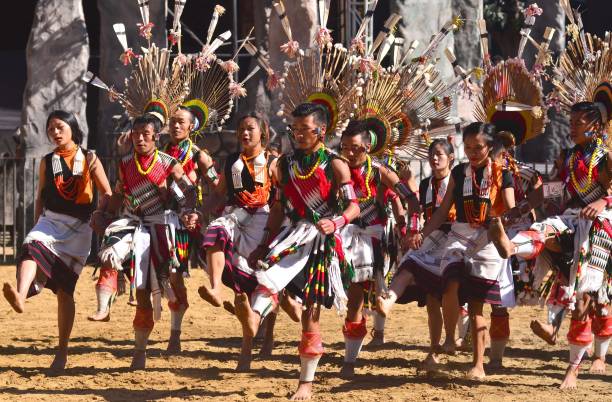The Angami Naga, one of the Naga ethnic groups, inhabits the Nagaland’s southern region, in the two administrative districts of Kohima and Dimapur. Chakhro Angami, Northern Angami, Southern Angami, and Western Angami are regional sub-divisions with 65 major villages and a total population of 141,732 (2011 Census). Kohima, the state capital, is located in the Kohima district at an altitude of 1444 meters above mean sea level.
The term ‘Angami’ is of non-Angami origin and is believed to be a corruption of the name ‘Gnamei’ given to them by the Manipuris (Hutton, 1969, p.14.). It is most likely a derivation from ‘N’gamei,’ the name referred to them by their southern neighbours, the Maram Naga of Manipur. According to legend, the Angamis arrived in Makhel, a village in the present Naga region of Manipur, from the southwest direction, which is also their closest history about their migration. They belong to the Tenyimia group which includes several other Naga tribes having common ancestry and speaks Tenyidie.

The Angamis referred to their ancient religion as Tsana/Krüna, which translates as ‘ancestral’ religion. Tsana’s followers believe in the embodiment of spirits known as ‘terhuomia.’ The word ‘terhuomia’ has both god and spirit form only its reference can conclude which element the speaker is referring to. They also believe in a Supreme Being called ‘Kepenuopfü’. Tsana is currently practiced by only a few Angamis. Christianity, which was first introduced in the last quarter of the nineteenth century, is now the dominant religion, accounting for more than 95 percent of the population.
They have a distinct political institution that aids in the administration of community life. The Angamis had a ‘pure democracy’ governing system, so each village was independent of the other. They were solely responsible for all judicial decisions. In case of emerging problems, it was discussed and solved by the elders known as ‘peyumia’ at a summoned meeting. The most appropriate resolution is reached, and the verdict is rendered. The village serves as a political unit, and within the village, ‘Khel forms the ‘village within a village.’This is the most important and effective institution in village governance (SHD Report 2004, p.40). The identity of a person is known by the clan, Khel and the village.
Morung (bachelor’s dormitory) or kichüki in tenyidie was the Angamis’ political and social centre. It functioned primarily to keep the village united and the cohesion of the whole community. It also served as a learning institution where the youths were taught and trained to shoulder the responsibilities of day to day life. However, with the introduction of western education, the significance of morung has declined and today it mainly stands to enrich the cultural heritage of the Nagas at large.
The village gate is a distinctive feature of Angami villages. To protect themselves from their enemies, each Khel has its own gate. On days when festivals are observed and rituals are performed, the gates are closed and it is forbidden for outsiders to enter the village.
The Angamis are an agrarian society. As a result, land and forest are the most important part of their economy. Similarly, the principal source of their revenue comes from their forests. Terrace cultivation is the most common, but jhum cultivation is also widely practised. They also domesticate cattle and other animals to supplement their agricultural income.

The Angamis have rich and vibrant traditional attires with which they adorn themselves during times of festivities. They are also skilled artisans, creating rich and sophisticated arts and crafts. They also knew the art of dyeing clothes and hairs.Even today, these arts and crafts provide a source of income for many people. Significantly, bamboo is widely used and has a significant impact on the lives of rural people, where it is used to make a variety of products, including household items and agricultural tools.
Throughout the year, various festivals are celebrated, the majority of which are related to agriculture. The Angamis’ most important festival, Sekrenyi (also known as Phousanyi), is officially observed on February 25th each year. It is a ten-day festival of sanctification for men (metaphysical as well). Its primary goal is to ensure good health and victory over their adversaries in the coming year.
———-
References
1. Hutton, J.H., (1969). The Angami Nagas. Bombay: Oxford University.
2. Nagaland, (2004). State Human Development Report 2004, Dept. Of Planning and Co-ordination, Govt. Of Nagaland.
3. Punyü, Vivolhuno, (2010). Traditional religious manifestations and its adherence in contemporary society: A case study. In NEIHA Proceedings, NEHU.
————
Contributed to the International Council of Naga Affairs (ICNA) by Dr Vivolhuno Punyü, Assistant Professor, Unity College, Dimapur, Nagaland. ICNA reserves all rights.
Featured Image: Angami Naga performs on the last day of the Hornbill festival at the Naga Heritage Village Kisama, some 10 kms away from Kohima, Nagaland on Monday, 10 December 2018. (Photo by Caisii Mao/NurPhoto via Getty Images)
Content Image: The Sacred Pear Tree at Shajouba/Vivolhuno Punyü; Village Gate/Avito Talie; Traditional ornaments/Angami Women Organisation souvenir; Adorned traditional finery during Thekranyi festival/Kejaroko Pierü. The picture has been reworked/merged by the International Council of Naga Affairs (ICNA).
———-
NOTICE: There are approximately 66/67 ethnic Naga groups. We only listed the Naga people’s nationality (ethnic Naga group) who had sent us a brief introduction. We welcome brief information (less than 1000 words) about each Naga people’s nationality/ethnic group. Please send the write-up submission to submissions@nagaaffairs.org with the subject line “For Naga People Listing.” It will be listed in the Naga “People” – Click Here

